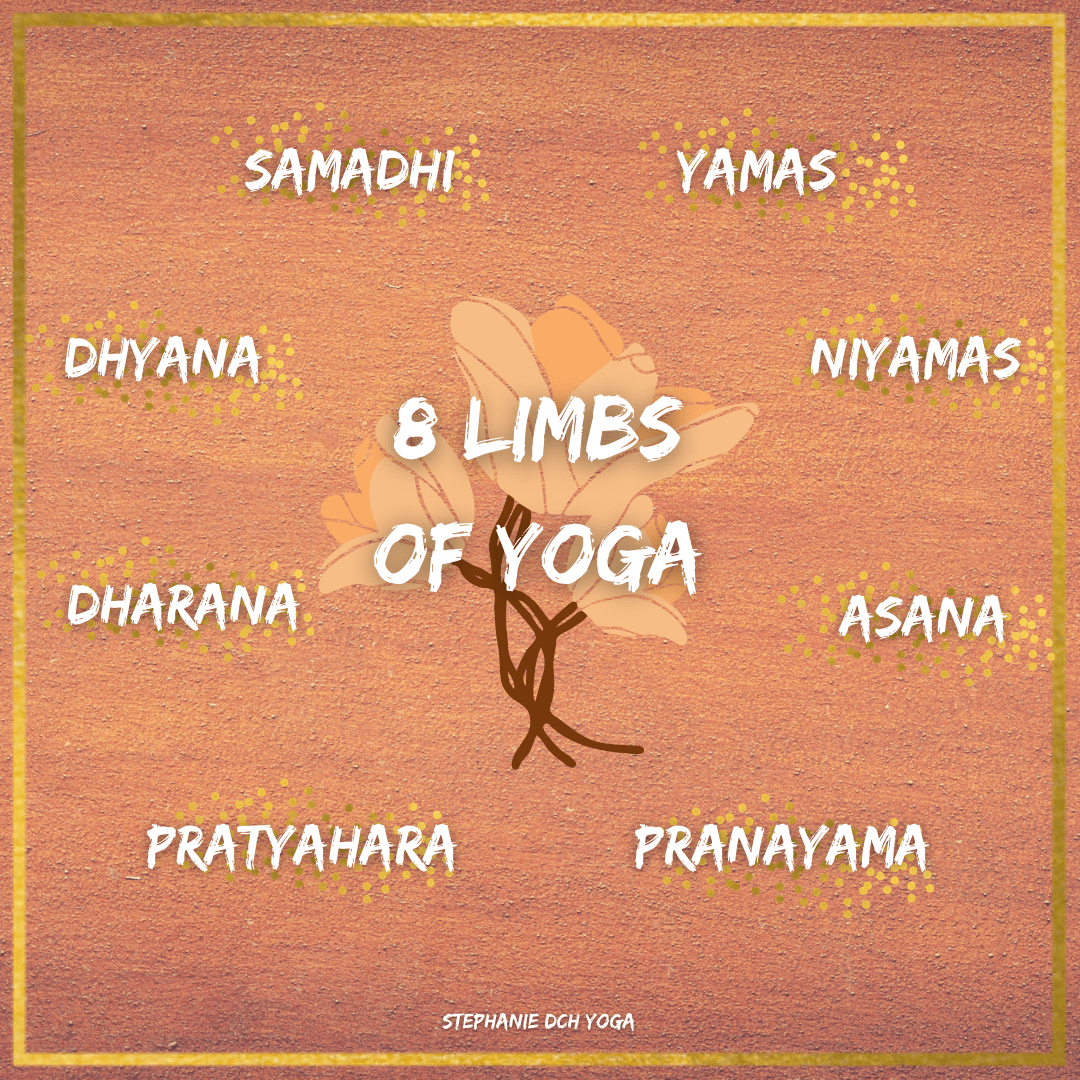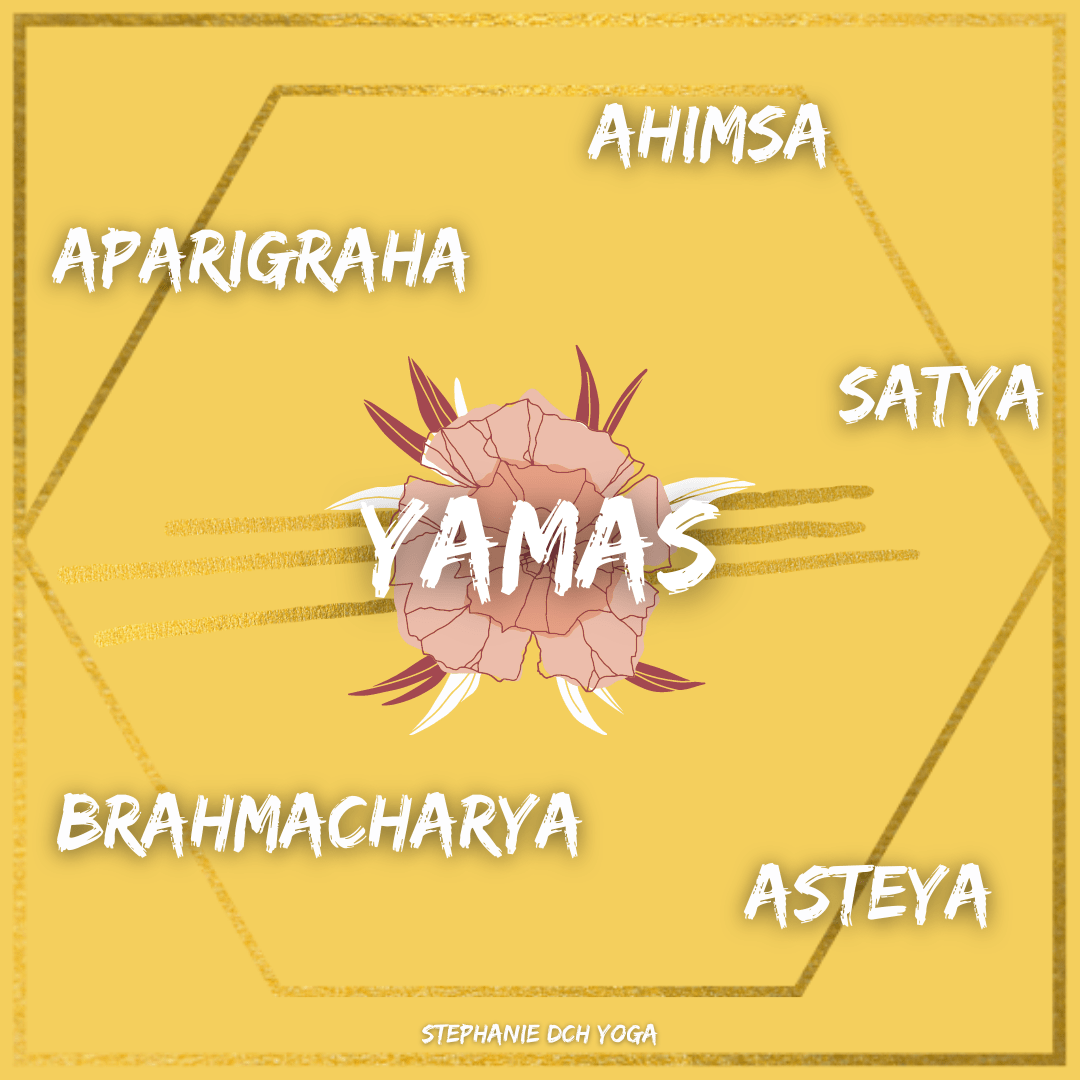Ahimsa
If you have been to my classes in Prestwood, Ballinger, Thame or online, you may have heard me talk about the 8 Limbs of Yoga. Yoga is not just the postures that we practice in class. Downward dogs and tree poses are the tip of the fascinating iceberg of Yoga. The postures, or asanas are just one of the eight. We have Yamas, Niyamas, Asana, Pranayama, Pratyahara, Dharana, Dhyana and Samadhi as you can see in this little infographic I had some fun making this week!

Over the next few weeks and months (and years?) I am going to delve into these ancient yogic concepts and base my classes on these different areas. Let’s start with the Yamas. These are a set of self- regulating behaviours, Yogic guidelines, or ethical codes which are fundamental to the practice and teaching of Yoga. Bear with, more Sanskrit words coming up…

The Yamas consist of five concepts which are Ahimsa, Satya, Asteya, Brahmacharya, and Aparigraha. There is a lot to look at, here, so let’s just take the first one for today; Ahimsa.

Ahimsa means Non-Violence. I am going to think on the bright side and assume that if you are reading this you aren’t an axe wielding murderer, and that you probably agree that violence isn’t cool. You may even be thinking, ‘I don’t slap people, this one is boring, NEXT’, but just hold on a bit longer as there is more to Ahimsa than avoiding inflicting physical harm.
When we talk about Ahimsa and non-violence, we are talking in terms of all living beings (including yourself!) and not just in a physical sense. Ahimsa means to be compassionate, loving, and non-violent in all ways including physical, emotional and mental.
How often have you berated yourself for not being able to fit everything in that you planned to do that day? Perhaps you pride yourself on being a ‘yes’ person, and do everything to help others but at the complete expense of your own wellbeing. Maybe you failed to be polite to a server at a café because they mucked up your order or you got frustrated with a needy pet and told them to go away? These are everyday examples of how we have probably all, at some point, been less than compassionate towards ourselves or others.
‘So I am supposed to be kind to everyone all the time even when they’re annoying?! What if someone wrongs me?!’
This is where the real Yoga practice comes in. Being compassionate requires us to accept events as they are and allowing things to just be when we have no control over the process or outcome. If we assume the Yogic concept of everything being connected, we realise that by hurting other beings we are hurting ourselves.
Boundaries
I think it is super important to caveat this with a little discussion on boundaries. I have lived a lot of my life trying to do what I thought other people wanted and I thought that this meant I was being a nice person. I think a lot of us do this, especially if you are empathic and hate to see others suffer. However, having good boundaries is the NUMBER ONE step to being compassionate towards yourself. I often have the little mantra pop into my head, ‘You can’t pour with an empty cup’. You cannot pour love and compassion into other people if you don’t have any for yourself. When I was younger, I thought I didn’t matter and sort of decided to martyr myself for others because I had such low self- worth. I have come to realise that this was not a sustainable way of thinking and that I have to put my needs first. This is really hard because it means learning to say ‘no’ to things, people and previous versions of yourself. It is mildly terrifying how much your life changes when you start saying, ‘no’. Everything starts to transform, from your priorities to your friends to your fashion sense. Saying, ‘no,’ can be a powerful form of self-love in the practice of Ahimsa.
It is okay to feel hurt, upset and angry at people and situations. These are normal emotions and it is vital that we allow ourselves to feel them! It is what we do with those emotions that matters. Ahimsa is about responding as opposed to reacting to things. Taking a moment to reinstate your boundaries in a compassionate way as opposed to telling someone to go f*ck themselves is the challenge. As someone with a lot of anger and a love of swear words, I empathise with you if you find this hard! Sometimes, responding with boundaries means walking away and letting things be.
Ahimsa supersedes all other Yogic concepts. As The Beatles so eloquently and cheesily put it, ‘Love is all you need’.
This is my understanding of Ahimsa, and it is a practice, not something to ‘achieve’.
The practice of Ahimsa in Yoga classes
As a teacher, Ahimsa is my first rule. If you have attended my classes, I am always repeating things like, ‘whatever feels good for you,’ ‘when you are ready,’ and, ‘listen to what your body needs today,’. I also try to give modifications and different versions of poses so that students can find a variation of a pose that will support them and allow them to feel good. This is a way in which I practice Ahimsa. It is of vital, utmost, 100% importance to me that a student feels safe in my classes. As a Yoga teacher, my advice to you is that if you EVER feel made to do something in a Yoga class that doesn’t feel right, RUN FOR THE HILLS! A Yoga teacher who inflicts pain or shame is not a Yoga teacher because they are ignoring a fundamental part of Yoga; Ahimsa.
As a student, Ahimsa is my first rule. How often have you pushed yourself a bit too far in a Yoga class and ended up in pain? Yanking yourself into a pose that your body doesn’t want to do is not loving. Taking a variation of a pose, if one is offered, or coming to a comfortable seat is Ahimsa. Asking the teacher for some help is Ahimsa. And if they respond negatively to this, that is THEIR PROBLEM and, again, you must RUN FOR THE HILLS.
Loving-Kindness Meditation to cultivate Ahimsa
Creating a meditation practice is a great way to practice Ahimsa. More specifically, we can practice Metta Bhavana to cultivate some loving vibes. ‘Metta’ comes from the Pali language, and means ‘love’ in the non-romantic, platonic sense. ‘Bhavana’ means to cultivate or develop. I created a video earlier this year of a Metta Bhavana or Loving-Kindness meditation which you can watch and listen to below!

Let me know how you get on with your practice of Ahimsa, and I am always up for discussing questions, theories and queries!
Lots of love
Stephanie x